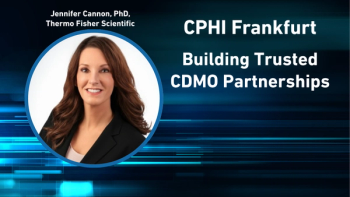
- Pharmaceutical Technology-08-01-2015
- Volume 2015 Supplement
- Issue 2
A Voice of Their Own
Contract development and manufacturing organizations join forces to address legislative, regulatory, and business concerns in the Pharma & Biopharma Outsourcing Association.
Contract manufacturing organizations (CMOs) and contract development and manufacturing organizations (CDMOs) play a key role in the formulation, development, analysis, and manufacture of drugs. Until recently, however, these organizations had little or no formal voice in legislative and regulatory issues that affect the bio/pharmaceutical industry.
In 2014, the Pharma & Biopharma Outsourcing Association (PBOA), a non-profit trade association, was established to advocate for the contract services market sector before regulatory, governmental, and legislative bodies, and to keep members informed of pressing industry developments. Gil Roth, president of PBOA, shared the organization’s mission and agenda with Pharmaceutical Technology.
PharmTech: Why do contract outsourcing firms need a trade association?
Roth: The number one reason is for advocacy; they need a voice with FDA and a voice with Congress. It’s something they really never had collectively. Some of the companies are very large and have strong regulatory affairs departments that have interaction with Washington; but many of these CDMOs just don’t have that degree of maturity when it comes to interacting with Capitol Hill and with FDA. More importantly, there are also areas where you simply can’t get in the door unless you are part of a trade association. That was the genesis for the PBOA.
When I was reporting on the first Generic Drug User Fee Amendment (GDUFA) in 2013, I noticed that some of the fees were structured in a way that hurt CMOs, and I began asking them ‘did you have any input, any way to amend?’ They said no, they were not invited. One or two of the CMOs asked to be part of the negotiations and were told, ‘No, you don’t have a trade association; we are only negotiating with trade groups.’
That started the ball rolling for PBOA. I started thinking beyond GDUFA: What other issues exist and what ways can we can help mature the industry and strengthen it by giving it a collective voice both in terms of the regulatory and legislative side, as well as in the general business area?
Building relationshipsPharmTech: Does the organization plan any formal relationships with other industry groups?
Roth: We are already working with the Parenteral Drug Association (PDA) and International Society of Pharmaceutical Engineers (ISPE). PBOA can build out legislative and regulatory advocacy arms, but rebuilding the scientific infrastructure that a group like PDA already would be redundant. PDA is interested in the CDMO perspective in particular, as it has requirements and needs that might differ from in-house pharma when it comes to the scientific and technical side of the business. We had been in conversations with them about building a partnership or interest group. As part of its mission, PDA explicitly avoids the advocacy side of what PBOA is doing. So in a sense, we can be complementary. We can pursue CDMOs’ areas of interest in terms of Congressional and regulatory representation, and we can also help them work with a group like PDA or potentially ISPE to advance some of the scientific and technical areas that they might not be getting addressed at present.
PharmTech: Has FDA had any response to the establishment of PBOA?
Roth: Response has been very good with FDA. We held a regulatory and legislative workshop in March in Washington, where we had two FDA participants speak, one from the Office of Generic Drugs and one from the Office of Pharma Quality (OPQ), and they both came away very impressed with what we put together. We are trying to let FDA understand what CMOs do and how that might differ as a business model from in-house pharma, in-house bio, and in-house generic businesses, and try to talk with them about how we can work together on regulations and guidance that might be better suited for impacting the CMO space.
Back in 2013, I mentioned the idea for the PBOA to an FDA policy advisor, and she was just thrilled with the idea because it would establish a single point of contact for the agency when it comes to CMO-related questions. The fragmented nature and historical issues with bringing this industry together do make it somewhat difficult for outside groups to figure out who to contact and how to get a CMO perspective. We want to be that point of contact, and I think we are already reaching that stage with FDA.
Addressing legislative issuesPharmTech: What involvement will PBOA have in legislative issues?
Roth: The 21st Century Cures Act came together in a big hurry and a lot of what’s in it got into it before the PBOA existed and had much traction on the Congressional side. We did have some conversations about a couple of things that would help CMOs with a few representatives, who hoped to get those into the Cures Act. We didn’t see those items in the final markup. Based on my conversations on Capitol Hill, a lot of people thought certain things were going to get into 21st Century Cures, but they didn’t. It is a very big and very complicated bill; we do hope that as it advances, it is going to help bio/pharma manufacturing overall and, as such, strengthen our sector, but there is nothing specific within it to assist or help our group.
The second five-year term for GDUFA will be negotiated this fall between FDA and industry interest groups, as they did with GDFUA I back in 2011 and 2012. We are hoping to be part of those negotiations, which will put us alongside the Generic Pharmaceutical Association, the Bulk Pharmaceutical Task Force, and the European Fine Chemicals Group; these were the groups that participated in GDUFA I, and I am assuming they will be part of this second round of negotiations. In the middle of June 2015, PBOA gave a presentation at a public hearing that FDA held for GDUFA reauthorization. We talked about the CMO sector, the importance of our industry, some of the issues that our members have with GDUFA and how it was implemented the first time around, and some of the improvements that we hope to see in the future version.
I was somewhat gratified that a House appropriations bill was issued a few days ago that included one of the areas of interest for us--which is shared by other industry interest groups--and that’s a waiver or reduction of GDUFA fees for smaller manufacturers, be they generic-drug companies or CMOs. It was just a line in the bill’s report recommending that FDA incorporate some sort of waiver and reduction into GDUFA II, and since that’s one of our points of interest, we are hoping to see that advance when GDUFA gets negotiated for reauthorization.
Defining qualityPharmTech: What is the PBOA’s position on FDA’s draft guidance, Contract Manufacturing Arrangements for Drugs: Quality Agreements? Is this guidance needed? What changes would the organization like to see?
Roth: A number of our members are happy to see FDA addressing quality agreements. It shows that FDA and its new OPQ have an interest and understanding in the CMO perspective. A senior policy advisor from that office spoke at our workshop in March on compliance trends, and I think she was very gratified to hear from CMOs how they work with clients on quality agreements. A lot of them shared best practices in terms of how they work with clients, how much of the quality agreement is generated from the CMOs side, how much flexibility you can have in terms of changing it given the number of clients that you have, and how you can’t exactly come up with a completely different quality system for every client who comes in the door.
We also did a survey on the topic of quality agreements to find out about how CMOs work with them, and we shared those findings with FDA. I am not sure there is a consensus on what CMOs want to see in the quality agreement guidance. Both members and nonmembers have asked about whether the PBOA could develop templates for quality agreements that could be adapted for their specific needs. When I talked with FDA about that, they seemed reticent about putting templates into a guidance document, because what tends to happen is that a company will use the template and say, ‘Look, we are compliant!’. FDA’s thinking is that the CMO and the client should be taking the responsibility, making sure they are doing the right thing when it comes the quality, and doing it in the flexible way that shows they understand what their systems are and understand what the client’s demands are.
To that end, some of the member companies have developed very thought-out, comprehensive quality agreements over the years. They read the guidance and they feel that they would be compliant with what FDA is recommending. They also said that their smaller clients are very happy to see that the CMO has already worked through so much of the process, given that for a lot of contract manufacturers, the small and mid-tier clients are the lifeline of the industry. It helps when the CMO can bring a lot to the table, can hold their hand a little bit and show them ‘This is what we have done with many clients before; this is how this relationship works.’ So at that end, they are happy that there is some guidance in place and some of them are very advanced in what they use for the quality agreement and how much leeway they have with it.
Seeing common goals
PharmTech: The organization has a unique structure; members who are competing for the same drug development and manufacturing business. So how do you reach a consensus among business competitors and get them to work together?
Roth: My take is that we have to be able to use the word ‘peers’ sometimes, just as we use ‘competitors.’ They understand that in some of areas there are common goals in terms of how to approach legislative and regulatory goals. What we are here to do is to strengthen the industry overall. It doesn’t benefit anyone to see a lot of smaller CMOs driven out of the market.
And to some extent, this is where my background is of real benefit. I never worked for a particular CMO. My involvement with the industry was as an editor covering it, before I took on this new role, so there is no perception that I am beholden to any one company. They know I treated them all pretty fairly in my previous role, and they trust me to do that moving forward. They understand that not every topic is going to be a 100% area of interest for them and that you have to compromise over some things. That’s all part of human nature, and part of having a trade association is understanding what somebody else’s goals are and how they don’t necessarily overlap with yours, but the benefits we get out of having this collective voice are more important than the single-driven goals that some of these companies have.
PharmTech: Your members manufacture innovator drugs, generic drugs, and small molecule and large molecule drugs; how do you manage competing interest in those areas?
Roth: As I said, with every group, you find that not everyone’s interests are 100% aligned. When I was first pitching the association to prospective members at the beginning of 2014, there were conversations about the small molecule vs. large molecule perspectives, the oral solid dosage vs. the injectables, the global multinational companies vs. the ‘mom-and-pop’ CDMO. What I tried to conveyâand what I think members ended up appreciating-was that while there are a lot of differences among them, there are common areas of interest and there was enough of an overlap and enough areas where it benefits them overall as a CMO industry to come together like this.
Take GDUFA fees: they do not impact all the companies the same way. I went through the self-identified facilities list and searched for each of our member companies, and found that 17 of PBOA’s 18 members do have final dosage form facilities that are subject to GDUFA fees. That doesn’t mean that GDUFA is the main area of interest. Some of those companies also have a generic business of their own. All of them understood the notion that something like generic-drug fees that are levied without your input aren’t always going to be a 100% overlap for them or 100% in their area of interest, but being part of an association not only gets them a seat at the table, it also brings them an outside voice. It brings me telling them, ‘This is what I am hearing in Congress, this is what I am hearing in conversations with various consultants and other industry groups’. Some of these companies are very busy, and they can’t necessarily keep up with everything on their own. So to that end, there are differences, but I think the commonalities are more important and that’s what we are really focused on.
GDUFA, serialization, and metricsPharmTech: What are your top initiatives for the next year?
Roth: First and foremost is the GDUFA II reauthorization. The negotiations are supposed to begin this fall. I am thinking that will run into 2016, so let’s count that as part of next year’s initiatives.
A second initiative is serialization, how CMOs implement it, and how they understand client demands. Recently, FDA delayed its compliance enforcement for pharmacies, in terms of the first stage of serialization and track and trace, but we know at some point, it’s going to come and that the CMOs have to be prepared for it; we want to work with them to help make that transition. That, in fact, is less of a regulatory and legislative issue and more of an industry-facing one. We want to make sure that our members are able the interact on the client side to understand client demands for serialization, not just in the United States, but how they can help implement the regulations and make sure they are compliant and the drugs they are manufacturing are going to be admissible in region after region as the serialization spreads out across the world.
The third area is the FDA’s quality metrics initiative; we have been talking with PDA and ISPE about that. We want to make sure that a CMO perspective is incorporated into that. CMOs manufacture for different clients, and we have to make sure the data disclosure that FDA might want fits with the nondisclosure agreements that these CMOs have with their clients and that it isn’t geared in such a way to inadvertently favor in-house manufacturing versus contract manufacturing. We want to make sure that the CMO perspective is represented in the way quality metrics are ultimately implemented by FDA. This is a very important area because there is lot of benefit that can come from having a quality metrics infrastructure in place, but it is also important to understand the differences in the types of manufacturing facilities that these different businesses have.
Article DetailsPharmaceutical Technology Outsourcing Resources Supplement
Vol. 39, No. 17
Pages: s24-s30
Citation: When referring to this article, please cite it as " A Voice of Their Own," Pharmaceutical Technology 39 (17) 2015.
Articles in this issue
over 10 years ago
Implementing FDA’s Electronic Labeling Proposalover 10 years ago
What’s Next for the CMO Industry?over 10 years ago
Opening Up Pharma Innovationover 10 years ago
Handling HPAPIs: Do Your CMOs Have the Right Stuff?over 10 years ago
Moving On to Implementation for Elemental Impurities Testingover 10 years ago
Multiple Partners, One Supply Chainover 10 years ago
Industry Viewpoints: Can Sterile Manufacturing Turn the Ship Around?over 10 years ago
Recovering the Value of Repurposed Drugsover 10 years ago
Serialization: Are You Prepared? Why This Time is DifferentNewsletter
Get the essential updates shaping the future of pharma manufacturing and compliance—subscribe today to Pharmaceutical Technology and never miss a breakthrough.





